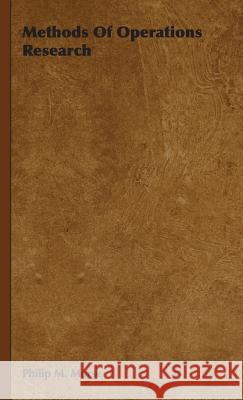Methods of Operations Research » książka
Methods of Operations Research
ISBN-13: 9781443725859 / Angielski / Twarda / 2008 / 172 str.
Methods of Operations Research
ISBN-13: 9781443725859 / Angielski / Twarda / 2008 / 172 str.
(netto: 192,82 VAT: 5%)
Najniższa cena z 30 dni: 187,52 zł
ok. 16-18 dni roboczych.
Darmowa dostawa!
METHODS OF OPERATIONS RESEARCH by PHILIP M. MORSE. PREFACE IN A SENSE, this book should have no authors names or else several pages of names Parts of the book were written by various persons during and at the end of World War II. What the undersigned have done is to collect the material, rewrite some in the light of later kno ledge, expand some to make it more generally intelligible, add chapters on organization and general procedures, and cement the mosaic into hat is hoped to be a fairly logical structure Since the undersigned were members of the Operations Research Gtuup, U. S, Navy, it is perhaps not surprising that the examples given are draun chiefly from the work of this group, though an effort has been made to include examples from the work of other groups Many persons have helped by discussions and editorial criticism, including members of other operations jf ear I roujis in this country and in Kngland To mention a few ould slight many others, so none l l c named. During the war the scope, methods, and triumphs of operations research ere not appreciated by most scientists or by most military men because no information was freely available If e are not to lose this valuable experience and background, some of it must be made available to the scientists and engineer as well ax to the artried services This is particularly important if the methods of operations research have important peacetime applications as it is believed they do. The first publication of this woik as in classified form, just after World War II. To further the purposes mentioned in the preceding paragraph, hem ever, the 1 volume has now been declassified, after suitable modification of a feu examples. The first and last chapters have been entirely rewritten, to bring the discussion up to date, in particular with respect to nonmihtury applications There has been growing interest in the application of the techniques of operations research in industry and other nonmihtary operations. This is evidenced by the formation of a committee on operations research of the U. S. National Research Council and of an Operations Research dub in London, and by the institution of classes in operations research in several American Universities. It is hoped that the present, unclassified edition of the book vill be equally of interest and of use to industrial, merchandising, and nonmihtary govern mental executives as the earlier, classified edition seems to have been in military circles. PHILIP M. MORSE. Contents include: 1 Introduction . .... 1 2 Probability . . . . . . . .... 11 3 The Use of Measures of Effectiveness . . 38 4 Strategical Kinematics . . . . ... .61 5 Tactical Analysis . . . . 81 6 Gunnery and Bombardment Problems . . . 110 7 Operational Experiments Auth Equipment and Tactics . . . 129 8 Organizational and Procedural Problems . . 137 Tables . . . .146 Bibliography . . . 154 Index . . . . ...
Operations research is a scientific method of gathering information to be used in high-level military decision-making, first originating in World War II. Written by a pioneer of operations research, this volume was designed for scientists, engineers, and other non-military professionals, discussing such topics as strategical kinematics, tactical analysis, gunnery and bombardment problems, etc. Contents include: “Introduction”, “Probability”, “The Use of Measures of Effectiveness”, “Strategical Kinematics”, “Tactical Analysis”, “Gunnery and Bombardment Problems”, “Operational Experiments with Equipment and Tactics”, “Organizational and Procedural Problems”, “Tables”, etc. Many vintage books such as this are becoming increasingly scarce and expensive. It is with this in mind that we are republishing this volume now in a modern, high-quality edition complete with the original text and artwork. This book was first published in 1951.











